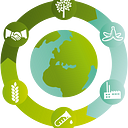The circular what? A tale of cities and the circular economy
Author: Anna Petit-Boix
Storms, flooding, drought, pollution… Lately, the media are full of stories showing us how challenging it is for cities to manage environmental events. Behind the bad news though, there are also good news. Local authorities around the world are strongly committed to adapting cities to the changing climate and to redefining urban lifestyles. In summary, cities wish to become more sustainable. What this means in reality remains oftentimes a mystery. Why? Well, if we take a look at local agendas, we get an idea of the number of sustainability concepts decision-makers deal with on a regular basis. Green growth, circular economy, bioeconomy, eco-cities, green cities… Every now and then, researchers and politicians come up with new models and priority action areas that need to be translated into real-life projects. They keep feeding the existing knowledge on sustainability and influencing the type of solutions taken up by cities. One thus wonders how cities manage to become more sustainable with such an overwhelming amount of concepts and goals.
Take the circular economy, for instance. This concept has been around for decades — perhaps passé at some point — until policymakers realized it was about time to bring it up again to solve resource scarcity and climate change and to create economic prosperity. A dream come true, one might think. The Ellen MacArthur Foundation, one of the main influencers when it comes to the circular economy, published a report in 2017 where the circular economy was seen as a tool to help decision-makers achieve urban goals. For example, it would support livability in the cities, increase their disposable income and reduce their carbon emissions. With such a tempting deal, why would cities not want to become circular and sustainable?
So yes, cities are definitely on board. But so far circular economy + city = blurry. How does a city become circular? My colleagues and I were decidedly planning a study to analyze the sustainability benefits of the circular economy in cities… until we realized we didn’t know what circular meant. Our solution: we looked for cities who plan or include the circular economy in their agendas and collected some information about the actions they had in mind. The result was quite unexpected. Personally, I thought they would all focus on recycling — come on, isn’t that what you all were thinking about after all? –, but the list got longer and longer. Cities are interested in planning resource-efficient and smart districts with their citizens. They encourage people to share tools, cars, bikes. Reducing plastic waste is obviously a hot topic. We found 21 groups of actions that cities relate to the circular economy. Complex, right?
It turns out cities don’t know for sure if these actions will make them more sustainable. Here is where science needs to step in. Cities need support. While they spend their local budgets on the circular economy, we don’t provide enough information on the sustainability implications of their actions. Our study also shows that research is not addressing social consumption (resource sharing, second-hand markets…) and urban planning actions from an environmental point of view. Are they decreasing their carbon emissions by sharing resources, for instance? Should cities focus on other actions to generate larger environmental benefits instead? I hope we get some answers soon to help materialize the sustainable circular cities of the future.
